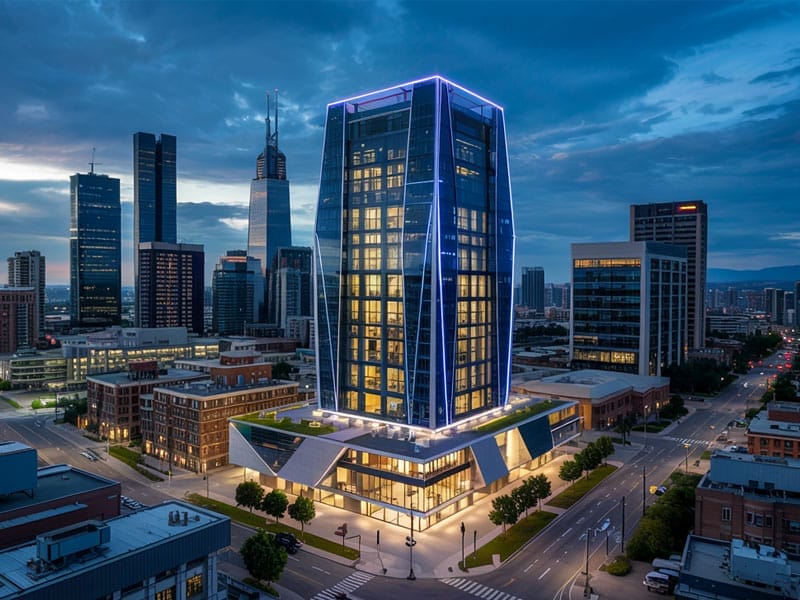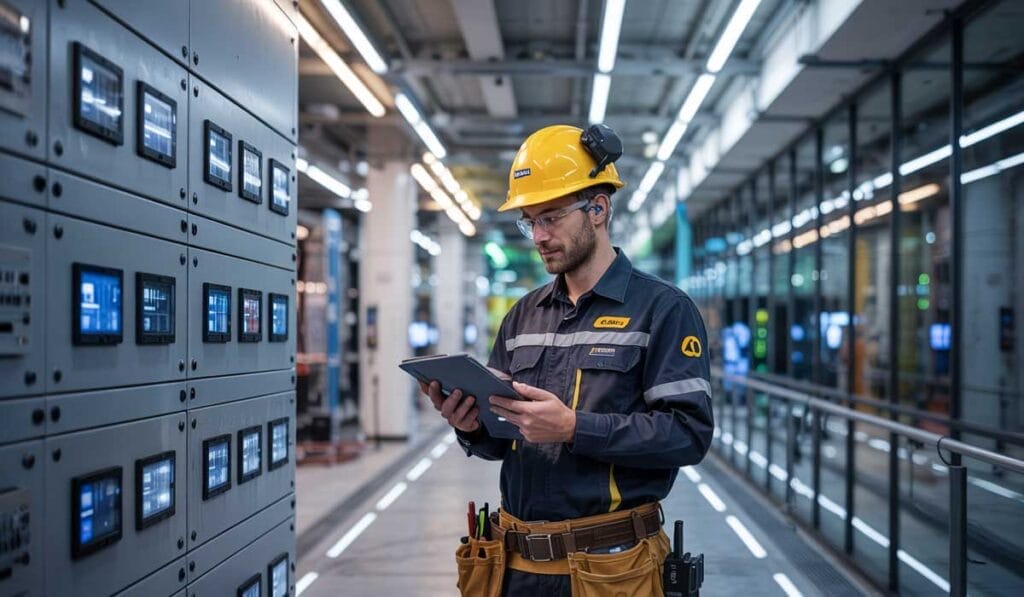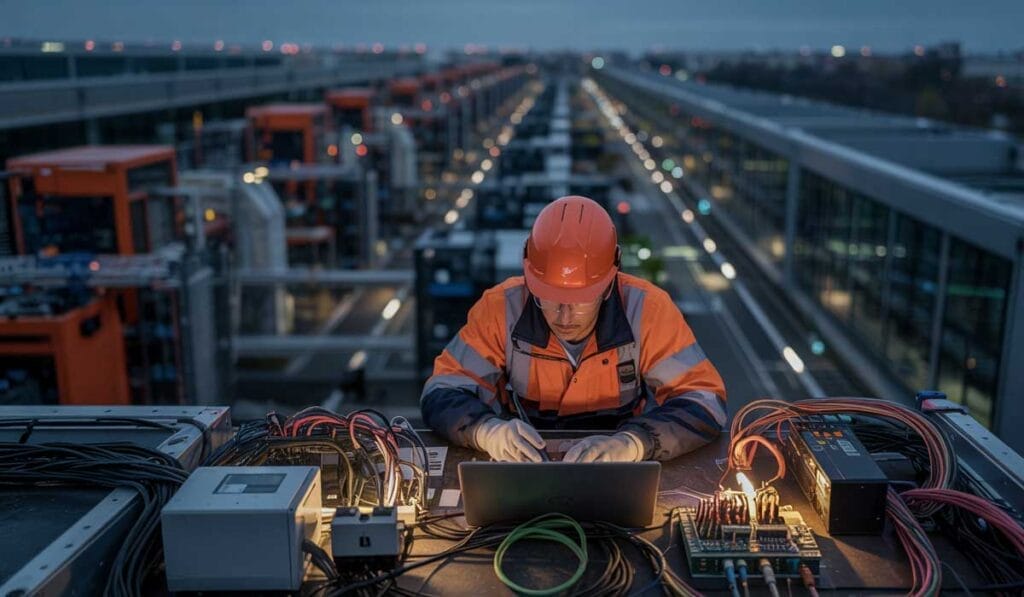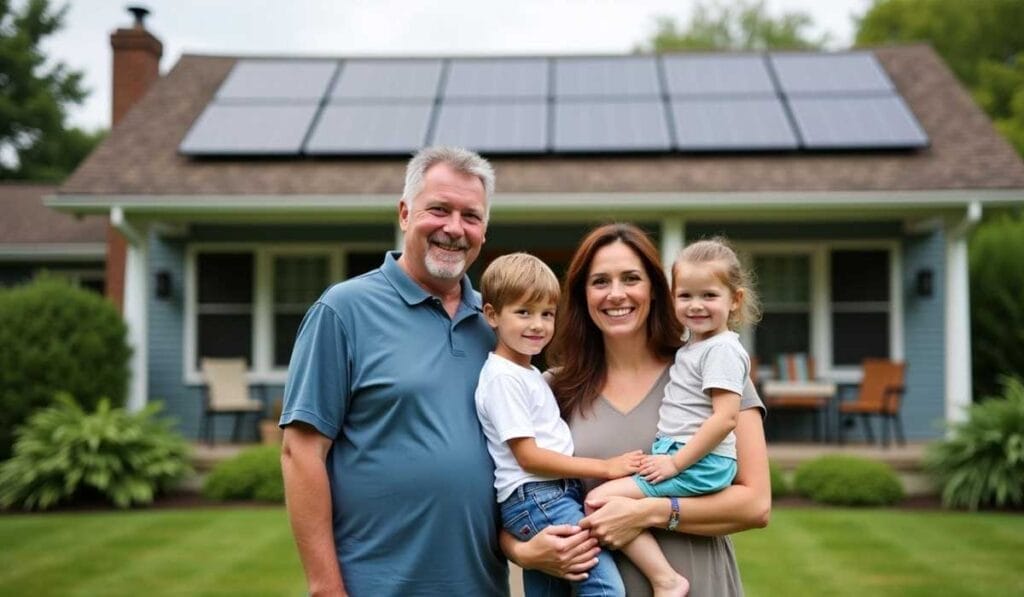
Smart Buildings: Opportunities For Electrical Contractors In Indiana
Electrical contractors have a golden opportunity in the fast-paced world of smart buildings.
Smart buildings reduce energy use and cut carbon emissions using advanced technology, including IoT devices and renewable energy sources.
Contractors can play a big part in this innovative field by getting involved.
They can help make buildings more efficient and eco-friendly.
Key Takeaways
- Smart buildings save energy and help the environment, offering new opportunities for electrical contractors.
- Electrical contractors must learn about IoT devices, AI, and renewable energy sources to stay ahead.
- These technologies require unique wiring and interconnected systems for efficient building management, but are challenging to install correctly.
- In Indiana, more people want smart homes and offices to reduce energy use and costs.
- Support from government policies and technology experts makes it easier for these professionals to adapt to smart building projects.
What Are Smart Buildings?

Smart buildings employ Internet of Things (IoT) technology to bolster efficiency.
This technological innovation regulates lights and climate based on presence, conserving energy and diminishing bills.
Such systems are pivotal for new architecture and modernized dated structures, including residences, commercial spaces, and multi-family homes.
By utilizing less energy, smart buildings contribute to the battle against climate change.
Within these intelligent structures, IoT technologies handle resources optimally.
They ensure energy isn’t squandered, decreasing greenhouse gas emissions.
Smart buildings aim to benefit both individuals and the environment by augmenting comfort and advocating eco-friendly lifestyles.
As our understanding of these technologies deepens, their importance in forging sustainable urban infrastructure becomes apparent.
Through instantaneous monitoring and anticipatory maintenance, they secure operational efficiency while reducing carbon footprints.
By embracing renewable energy sources, such as solar panels, in their construction, these edifices champion the movement toward greener energy solutions.
Moreover, features like intelligent thermostats modulate based on factual necessities, preserving energy more effectively.
Such a strategy addresses climate change challenges and fosters a circular economy by capitalizing on existing resources sans waste.
Key Technologies in Smart Buildings

Smart buildings use internet-connected devices, digital twin technology, machine learning, and solar panels to improve efficiency and function.
These technologies reduce energy consumption and carbon dioxide emissions while enhancing operational efficiency.
Internet of Things (IoT)
IoT enhances the efficiency of smart buildings by conserving energy and optimizing processes. Systems link lighting, thermostats, and security cameras through the internet, allowing simple oversight through a phone or computer.
In Indiana, the preference for these technologies is growing because they minimize electricity consumption and simplify tasks.
As an electrical contractor, this trend provides you with extra possibilities. You will set up sensors that monitor energy consumption and gadgets that connect online. Adopting IoT benefits the environment and aligns with customer expectations for energy conservation.
Familiarizing yourself with IoT can be greatly advantageous for your enterprise.
Building Information Modeling (BIM)

BIM changes how smart buildings are designed and managed.
It helps electrical contractors in Indiana and elsewhere focus on energy efficiency.
Your use of BIM contributes to creating less power-hungry buildings that also help protect the environment.
By working with engineers and technology experts, you create self-regulating buildings.
This approach opens doors to a future where construction reduces carbon footprints through smarter energy management.
With BIM, installing solar panels or smart thermostats becomes more efficient by showing the best methods and locations.
This capability helps make buildings more sustainable while keeping you competitive in a rapidly changing industry.
Artificial Intelligence (AI)
Artificial Intelligence (AI) transforms buildings’ operations, enhancing energy efficiency and system reliability.
AI serves as the controlling mind for energy use, ensuring lights and heating systems only run when necessary.
This reduces power consumption and cuts down carbon emissions.
As an electrical contractor, AI allows you to engage with intelligent systems that preemptively identify maintenance needs.
You’ll install devices that learn and adjust to optimize building functions.
With the rise of smart buildings, your ability to integrate and manage these technologies will become crucial.
Gaining skills in AI will position you well within the sustainable development sector.
Renewable Energy Integration
Renewable energy presents substantial opportunities for electrical contractors in Indiana, Kentucky, and central/southern Illinois.
You can use solar panels to modernize the power grid.
This task goes beyond mere installation and ensures structures utilize cleaner energy sources.
Solar panels transmute sunlight into electricity for offices and homes.
This operation necessitates modernizing electrical systems to achieve efficiency and fulfill decarbonized energy transition objectives.
Crucial to this is the fusion of IoT devices with clean energy.
Renewable energy projects contribute to grid modernization and progress towards low-carbon targets.
They render buildings more energy-conservative and diminish their carbon footprint.
Opportunities for Electrical Contractors in Smart Buildings

Installing IoT devices and improving power systems can add value to smart buildings.
This work boosts energy efficiency and offers exciting opportunities.
Installation of IoT Devices and Sensors
Indiana is seeing a rise in smart buildings, and now is a great time to get involved.
- IoT (Internet of Things) makes smart buildings more efficient.
- Your role could involve installing small devices and sensors to manage lighting, temperature, and energy use.
- Installing systems that monitor energy use in real-time can reduce business power bills.
- Understanding IoT allows you to work on residential and large office projects as demand increases.
- Beyond controlling lights, sensors can detect issues early, reducing emergency repairs.
- The need for professionals skilled in smart technology is growing quickly in Indiana as more projects develop.
- Implementing these systems benefits your business and supports greener building practices by lowering water consumption and carbon emissions.
Getting skilled in IoT sets you up for future success.
Start now to take advantage of the expanding opportunities in smart building technologies.
Upgrading Electrical Infrastructure
You play a significant role in transforming buildings to make them more intelligent.
- Begin with enhancing electrical systems for advanced technologies. The smooth functioning of intelligent buildings depends heavily on these systems.
- Become accustomed to Internet of Things (IoT) devices. These add intellect to buildings but necessitate unique wiring and robust connectivity.
- Dispose of old wires and panels. This ensures safety and boosts efficiency.
- Integrate renewable energy sources such as solar panels and wind turbines. These lower energy costs reduce carbon emissions.
- Concentrate on energy efficiency. Implement intelligent energy management systems that modify energy consumption in real time.
- Set up intelligent lighting systems. These conserve power by adjusting to levels of natural light.
- Prioritize data protection. Cybersecurity measures are crucial to shielding against potential cyber threats.
- Advocate for grid modernization. This enables buildings to link to advanced electrical grids effortlessly.
- Ongoing education is essential in this dynamic field. Staying updated with green building and climate control technologies is crucial.
Enhancing electrical systems opens opportunities for profitable projects and contributes towards a more sustainable future.
Integration of Renewable Energy Systems
Smart buildings employ renewable energy to improve efficiency.
If you are an electrical contractor in Indiana, Kentucky, or Central/Southern Illinois, your expertise can significantly contribute to this transition.
- Solar panels convert sunlight into electricity, lessening the reliance on conventional power sources and augmenting energy efficiency.
- Wind turbines transform wind into electricity. Their installation provides eco-friendly solutions for expansive areas, despite being intricate.
- Battery storage units store excess power generated from solar panels or wind turbines. They prove crucial for steady energy provision, particularly during periods lacking sunlight or wind.
- Intelligent energy management systems boost energy utilization through data analytics. They also instantly assist buildings in reducing their carbon emissions.
- Updates for grid modernization are essential as more renewable energy sources integrate, guaranteeing efficient, clean power distribution.
- Direct air capture technology extracts carbon dioxide from the atmosphere. This technique is revolutionary for those eager to contribute to superior climate change solutions.
These measures not only make buildings environmentally friendly, but also generate new business opportunities.
With the increasing dependence on renewable energy, your abilities are sought to facilitate the construction of this freshly powered-by-renewables environment.
Ensuring Energy Efficiency and Sustainability
Smart buildings save energy and protect our planet.
They use Internet of Things (IoT) for efficiency and reduced waste.
As an electrical contractor, you play a key role. You install IoT devices and ensure buildings consume less power.
Options include adding solar panels or using smart lighting that dims when rooms are empty.
These buildings also prioritize renewable energy, such as wind or solar, over coal or gas.
This reduces carbon emissions and saves money long-term.
Your work supports climate change efforts and keeps business costs low.
Challenges may arise in your projects.
Challenges Electrical Contractors May Face

Electrical contractors face challenges with smart buildings, such as mastering IoT and AI technologies while following strict regulations.
Learning to manage these can lead to success in this rapidly growing field.
Adapting to New Technologies
Adopting new technology such as the Internet of Things (IoT) and intelligent systems is essential.
Smart buildings are gaining popularity, and renewable energy and artificial intelligence are utilized for superior operation.
By blending these technologies, you acquire proficiency in contemporary energy solutions.
Installing solar panels or improving buildings with AI and IoT tools minimizes carbon footprints and economizes future energy expenses.
This progression to intelligent buildings offers chances for leading-edge innovation and financial preservation through effective energy use.
Managing Complex Smart Systems
Managing smart systems involves balancing many elements.
You simultaneously manage IoT devices, cybersecurity measures for data protection, and energy management.
Your goal is to keep these components functioning seamlessly.
Your job is to ensure that different technologies communicate effectively.
This requires transforming complex tech language so every part of the system works in harmony.
You combine technical expertise with knowledge of grids, renewable energy like solar panels, and safety regulations.
These standards change frequently, but you adapt quickly to maintain a secure and efficient setup.
Meeting Regulatory and Safety Standards
Keep up with smart tech rules for success in smart building jobs.
Updating your knowledge on regulations and safety is key. This ensures smooth project execution.
Following standards goes beyond obeying the law; it enhances building safety and intelligence.
Your work contributes to carbon reduction and energy management.
Staying informed sets you apart in Indiana, Kentucky, and Central/Southern Illinois markets.
Strategies for Electrical Contractors to Succeed

To thrive in smart buildings, you must master new technologies like IoT and AI—partner with tech experts to enhance buildings’ energy efficiency and operation.
– Learn IoT and AI for smarter energy management.
– Collaborate with technology experts to ensure efficient building operations.
Invest in Continuing Education and Training
Keep learning new skills as an electrical contractor, stay updated with smart technologies, and take part in training for IoT integration in homes and office buildings.
Tech moves fast, and so should you.
Continuous education keeps you competitive.
For success, be aware of the latest trends in smart building technologies.
Understanding energy management systems and ways to lower carbon footprints is essential.
Knowledge about solar panels and cybersecurity measures also effectively meets industry needs.
Collaborate with Smart Technology Providers
When you work with experts in smart technology, including the Internet of Things (IoT), artificial intelligence (AI), and renewable energy, you gain an edge.
These partnerships provide insight into the latest devices and methods for saving energy.
They act as a roadmap for enhancing homes and buildings with smart solutions.
Collaborating in this field attracts more clients seeking smart technologies for their spaces.
This increase in demand leads to more opportunities for installing devices or improving energy management.
As a result, satisfied customers often refer others, boosting your business through expertise in advanced technologies from these partnerships.
Focus on Delivering Energy-Efficient Solutions
Working with smart technology providers is a first step.
Switching to energy-efficient solutions attracts environmentally conscious clients.
Installing low-power systems saves money and helps the planet.
Smart buildings are leading this shift, using IoT to monitor energy use and find savings.
As an electrical contractor, you have an opportunity to enhance these buildings with solar panels and renewable energy technologies.
Clients appreciate lower electricity bills and the contribution they make to environmental protection.
Smart buildings offer significant potential for energy savings.
The Future of Smart Buildings in Indiana and Beyond

Smart buildings in Indiana and elsewhere are integrating solar panels and advanced energy management systems.
These improvements aim to reduce energy consumption and make communities more sustainable.
Increasing Demand in Residential and Commercial Sectors
Homes and offices in Indiana are becoming energy-efficient with the help of smart technology.
These buildings save power, enhance security, and automate systems for convenience.
As an electrical contractor, this shift opens up more job opportunities.
Your role involves installing solar panels, improving data center cooling methods without increasing energy use, and integrating Internet of Things (IoT) devices to control lighting and heating efficiently.
The Role of Government Incentives and Policies
Government incentives and policies support the growth of smart buildings in Indiana.
These measures encourage IoT and other advanced technologies in construction projects.
With each new policy, opportunities increase for electrical contractors to adopt innovations.
Initiatives aim to enhance building energy efficiency and sustainability.
Partnering with the public sector offers access to funding and resources for implementing technologies like carbon capture or small modular reactors.
This collaboration promotes a greener future while boosting your business.
Conclusion

Get ready for smart buildings. They’re the future. As an electrical contractor in Indiana or elsewhere, you must learn about IoT technology and AI.
You’ll face challenges like new technologies and strict standards, but your skills are crucial for lighting up buildings innovatively.
Keep learning and stay eager to explore smart building technology together.
FAQs
1. What are smart buildings, and why are they rising?
Smart buildings, powered by artificial intelligence (AI) and Internet of Things (IoT), use real-time monitoring, data analytics, and predictive maintenance to boost operational efficiency. They’re gaining traction due to their energy-saving capabilities and ability to reduce carbon footprints.
2. How can electrical contractors in Indiana benefit from this trend?
Opportunities abound for electrical contractors as demand grows for grid modernization, renewable energy sources like solar panels, and the installation of smart energy management systems. Plus, cybersecurity measures are needed to protect these high-tech structures.
3. What role does AI play in the operation of smart buildings?
AI is pivotal in managing energy transition within these structures by optimizing usage patterns through data centers, which conserve energy while maintaining comfort levels.
4. Can smart buildings contribute towards reducing climate change concerns?
Absolutely! Smart Buildings employ sustainable practices, such as using renewable energies or even small modular reactors (SMRs), which offer new energy solutions with lower carbon emissions than traditional power plants.
5. Is there a link between the rise of smart buildings and nuclear power development?
Indeed! The push towards greener built environments has sparked interest in nuclear power plants, which have the potential to generate carbon-free electricity.
6. How do smart buildings ensure data security amidst all these advancements?
Data security is paramount in this digital age; hence, robust cybersecurity measures are integrated into the design of these structures, along with regular updates that respond swiftly to any supply chain disruptions or threats.
